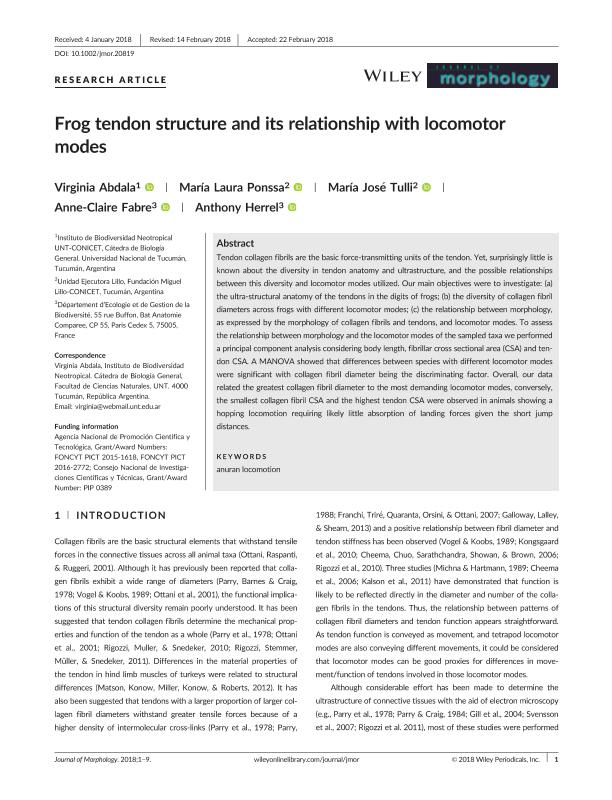Artículo
Frog tendon structure and its relationship with locomotor modes
Abdala, Virginia Sara Luz; Ponssa, María Laura ; Tulli, María José
; Tulli, María José ; Fabre, Anne Claire; Herrel, Anthony
; Fabre, Anne Claire; Herrel, Anthony
 ; Tulli, María José
; Tulli, María José ; Fabre, Anne Claire; Herrel, Anthony
; Fabre, Anne Claire; Herrel, Anthony
Fecha de publicación:
03/2018
Editorial:
Wiley-liss, Div John Wiley & Sons Inc
Revista:
Journal of Morphology
ISSN:
0362-2525
Idioma:
Inglés
Tipo de recurso:
Artículo publicado
Clasificación temática:
Resumen
Tendon collagen fibrils are the basic force‐transmitting units of the tendon. Yet, surprisingly little is known about the diversity in tendon anatomy and ultrastructure, and the possible relationships between this diversity and locomotor modes utilized. Our main objectives were to investigate: (a) the ultra‐structural anatomy of the tendons in the digits of frogs; (b) the diversity of collagen fibril diameters across frogs with different locomotor modes; (c) the relationship between morphology, as expressed by the morphology of collagen fibrils and tendons, and locomotor modes. To assess the relationship between morphology and the locomotor modes of the sampled taxa we performed a principal component analysis considering body length, fibrillar cross sectional area (CSA) and tendon CSA. A MANOVA showed that differences between species with different locomotor modes were significant with collagen fibril diameter being the discriminating factor. Overall, our data related the greatest collagen fibril diameter to the most demanding locomotor modes, conversely, the smallest collagen fibril CSA and the highest tendon CSA were observed in animals showing a hopping locomotion requiring likely little absorption of landing forces given the short jump distances.
Palabras clave:
ANURAN LOCOMOTION
Archivos asociados
Licencia
Identificadores
Colecciones
Articulos(IBN)
Articulos de INSTITUTO DE BIODIVERSIDAD NEOTROPICAL
Articulos de INSTITUTO DE BIODIVERSIDAD NEOTROPICAL
Articulos(UEL)
Articulos de UNIDAD EJECUTORA LILLO
Articulos de UNIDAD EJECUTORA LILLO
Citación
Abdala, Virginia Sara Luz; Ponssa, María Laura; Tulli, María José; Fabre, Anne Claire; Herrel, Anthony; Frog tendon structure and its relationship with locomotor modes; Wiley-liss, Div John Wiley & Sons Inc; Journal of Morphology; 279; 7; 3-2018; 895-903
Compartir



